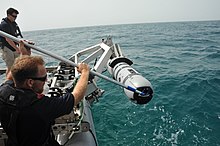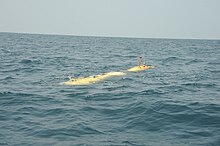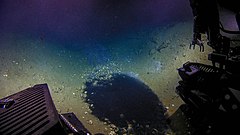Unmanned underwater vehicle
[6] When the Russian Institute of Marine Technology Problems introduced the Solar Autonomous underwater vehicle (SAUV), it was the start of longer term exploration missions without the need of retrieving the UUV for maintenance.[6] Advancements in battery life enabled for the creation of “gliders” in 1995 which would allow for the long term dives in which the UUVs would remain submerged for weeks or even months at a time.[7] On December 16, 2016, a Chinese warship in South China Sea seized an underwater drone that was in the process of being retrieved by the U.S. Navy survey ship USNS Bowditch.[14][15] According to DARPA, Manta Ray demonstrates a first-of-its-kind capability for an extra-large UUV due to its "cross-country modular transportation, in-field assembly, and subsequent deployment.[23] Individuals from the Indonesian military have categorized the vehicle to be a Chinese Sea Wing (Haiyi), created for the purposes of collecting data including water temperature, salinity, turbidity, and oxygen levels that can help chart optimal submarine routes.[23] The navies of multiple countries, including the US, UK, France, India, Russia, and China[24] are currently creating unmanned vehicles to be used in oceanic warfare to discover and terminate underwater mines.A survey conducted by RAND Corporation for the US military analyzed the missions which unmanned underwater vehicles could perform, which included intelligence, reconnaissance, mine countermeasures, and submarine warfare.[26] In November 2022, the Eurasian Times reported that China's Harbin Engineering University has developed trans-medium 'flying submarine' drones capable of both underwater and air travel, noting the potential military applications of the vehicles.Ross Lindman (director of operations at the company's technical solution's fleet support group) stated that "The big significance of this is that we ran the full kill chain"."[29] The final demonstration for unmanned underwater vehicles was displayed by General Dynamics, the company showcased their cross-domain multi-platform UUV through a theater simulating warfare planning tool.James Langevin, D-R.I., ranking member on the House Armed Services Committee’s subcommittee on emerging threats, stated in regard to this exercise "What this is all driving to is for the warfare commander to be able to make the decisions that are based on what he thinks is high-confidence input quicker than his adversary can," he said."[29] These exercises were conducted to showcase the applications of unmanned underwater vehicles within the military community, along with the innovations each company created to better suite these specific mission types.[29] UUVs were also used to film a recent National Geographic documentary called "The Dark Secrets" of the Lusitania, the British ocean liner that the Germans sank during World War 1.[30] Argo, a UUV developed by the Woods Hole Oceanographic Institute (WHOI), helped find the wreckage of the Titanic and was equipped with a set of television cameras to capture views of the ship.[31] Footage captured by Argo was included in the 1986 National Geographic documentary Secrets of the Titanic that details an expedition led by Dr. Robber Ballard and lets viewers take a closer look at the wreckage of the ship.For example, remotely operated vehicles have been used to collect samples from the sea-floor to measure its microplastics-contents,[32] to explore the deep-sea fauna and structures and discovering new underwater species.The Woods Hole Oceanographic Institution employs a vehicle called the Sentry, which is designed to map the ocean floor at depths of six thousand meters.[35][36][37] Science Direct claims the use of Unmanned Underwater Vehicles has risen consistently since they were introduced in the 1960s, and find their most frequent use in scientific research and data collection.[38] Duro helps the New York City government collect data around Randall's Island Park Alliance to monitor water quality and wetland health in the East and Harlem Rivers.



Sullivan Regional Airportsubmersibleremotely operated underwater vehiclesautonomous underwater vehiclesremotely controlledautomatedRemotely Operated Underwater Vehicles (ROUVs)US NavyAutonomous Underwater Vehicles (AUVs)University of WashingtonSouth China SeaU.S. Navysurvey shipUSNS BowditchChinese Defense MinistryThe PentagonUkraineBlack SeaBrave1Northrop GrummanParacel IslandsSeafoxIraq WarUmm QasrSelayar IslandRAND Corporationreconnaissancemine countermeasuressubmarine warfareHarbin Engineering Universityflying submarinePoseidonpump-jetblurred outStatus-6 Oceanic Multipurpose Systemnicknamednuclear poweredRussianuclear warheadAegis Ballistic Missile Defense SystemmegatonssonobuoyHuntington Ingalls Industriessynthetic aperture sonarGeneral DynamicsLittoral combat shipLusitaniaWorld War 1Woods Hole Oceanographic Institute (WHOI)TitanicNational GeographicSecrets of the TitanicDr. Robber BallardmicroplasticsHydrothermal ventseafloor mappingbathymetryWoods Hole Oceanographic Institutionbioinspiredsoft robotMariana Trenchexplorationenvironmental monitoringAutonomous underwater vehicleNew York CityHarlem Riverselectromagnetic wavesAcoustic waveacoustic positioningRadio-controlled submarineRemotely operated underwater vehicleChase, ZannaLaschi, CeciliaBibcodeWayback MachineMobile robotsuncrewed vehiclesUnmanned aerial vehicle (UAV)Unmanned combat air vehicle (UCAV)AerobotHelicamList of unmanned aerial vehicle applicationsOrnithopterWalkingHumanoidAndroidHexapodUnmanned ground vehicle (UGV)Automated guided vehicle (AGV)Self-driving carAutomatic train operation (ATO)Autonomous underwater vehicle (AUV)Intervention AUV (I-AUV)Remotely operated underwater vehicle (ROUV)Underwater gliderUnmanned surface vehicle (USV)Uncrewed spacecraftlist of probeslist by programlist of orbitersCargo spacecraftspaceflights to the ISSSpace telescopeDomesticMilitaryRescueMedicalDisabilityAgriculturalBEAM roboticsMicroboticsNanoroboticsRoboticsRobot locomotionAutonomous robotAutonomous logisticsRadio-controlled modelRemote control vehicleRemote control animalOutlineGlossaryHistoryGeographyHall of FameEthicsCompetitions
